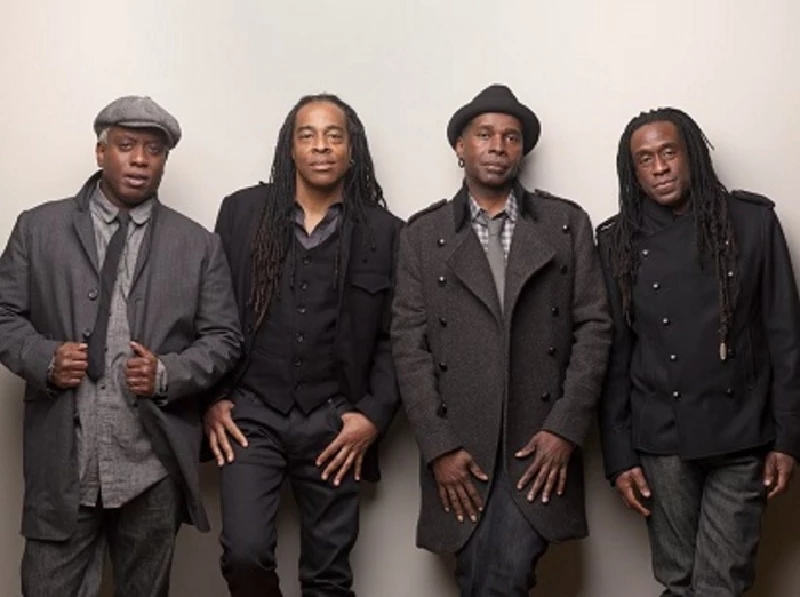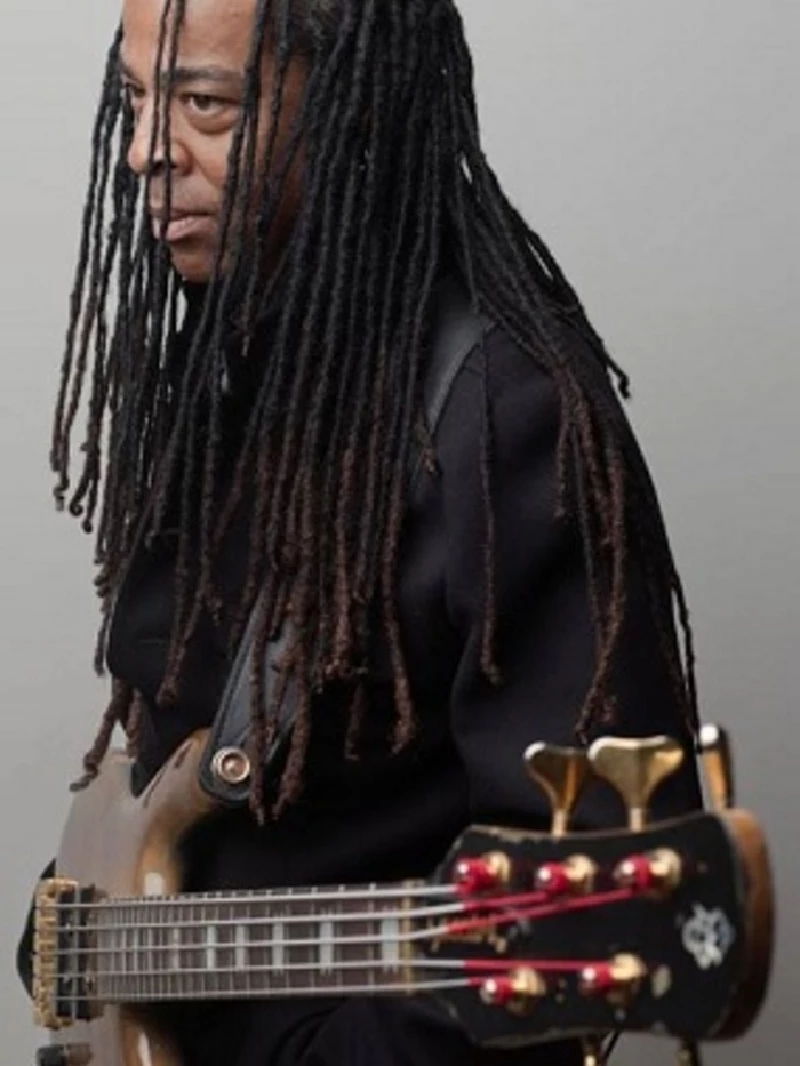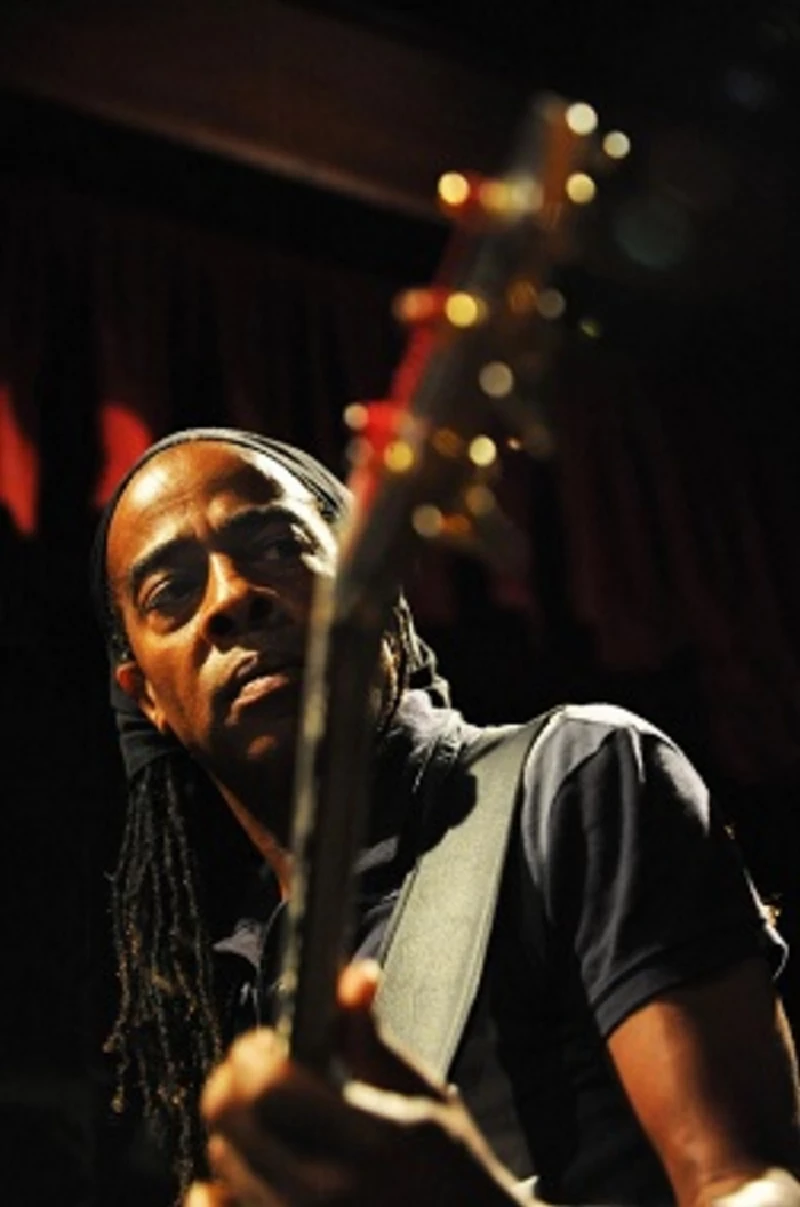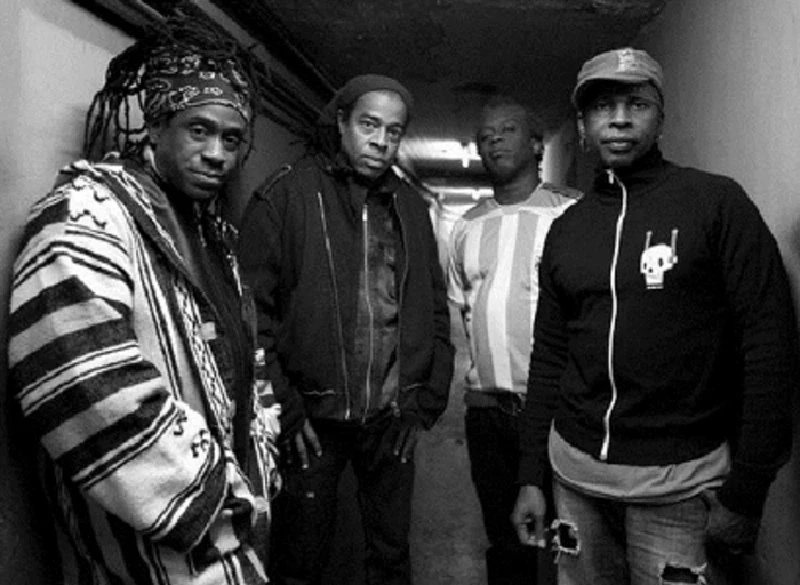Living Colour - Interview
by Lisa Torem
published: 6 / 6 / 2014

intro
Lisa Torem speak to Doug Wimbish, the bassist with Living Colour, about his band's career and their involvement in a new covers EP of Paul McCartney covers
Hartford, Connecticut native Doug Wimbish began playing bass as a teen. With guitarist Skip McDonald and drummer Keith LeBlanc, he created the legendary Sugarhill Records rhythm section in 1979 where his alternative bass tunings substantially influenced major international bands in the rock and hip hop genres. Half a decade later, the same trio formed Tackhead with producer Adrian Sherwood in London. At the end of the decade, Wimbish collaborated with long time Rolling Stones’ backing vocalist Bernard Fowler, which led to his participation in their 1997 'Bridges to Babylon' album. Wimbish joined New York-based rock band, Living Colour in 1992. His work with them includes the albums, 'Stain'(1993), 'Collideoscope' (2003) and 'The Chair in the Doorway' (2009). Besides Wimbish, the current line-up consists of guitarist Vernon Reid, lead vocalist Corey Glover and drummer Will Calhoun. He also formed Jungle Funk with Will Calhoun and Vinx. His solo albums include 'Trippy Notes for Bass' in 1999 and 'CinemaSonics' in 2008. Wimbish continues recording and touring internationally with Living Colour, a band known for merging jazz, funk, hip hop and metal. They are most widely known for their acclaimed 1988 album 'Vivid', garnering a Grammy for Best Hard Rock Performance in 1990 for their single 'Cult of Personality', and being cited Best New Artist at the 1989 MTV Video Music Awards. Living Colour is also known for creating lyrics, which spark social activism. To that end, they were recently invited to participate in the Santa Fe University of Art and Design’s Artists for Positive Social Change Series. Wimbish has performed with Jeff Beck, Mick Jagger, Seal, Madonna, Joe Satriani, Billy Idol, Mos Def, Depeche Mode, Tarja and many other popular artists. Wimbish most recently got involved with the Alan Aldridge Illustrated Collective Set and CD project, which features classic material by Paul McCartney/Beatles reimagined by a series of diverse artists. In interview with Pennyblackmusic, the optimistic Wimbish explains how “saying yes” often leads to the exploration of undiscovered avenues and the reaping of respective rewards, and how synchronicity played a huge part in this recent album project despite snowy days and maddening schedules. PB: You are known not only for playing bass but for your imaginative sound effects. You recently worked on the Alan Aldridge Illustrated Collective Set and CD of Beatles and McCartney Classics. How did your arrangements for this take shape? DW: Well, to be honest, it was kind of done in bits. Myself and RJ (Robert Johnson - LT), the producer, got together and primarily did the basic track arrangement at first and because of everybody’s availability at that time – everybody was in different places – the tracks started with my doing the drum beat and RJ playing some guitar and me playing bass and doing it in bits. And I got Corey (Glover - LT) to come in and do the vocals and then I got Will (Calhoun - LT) to come in and do the drums. At the end, Vernon Reid did the guitars. We weren’t all in the room at the same time. It was just something that evolved based on the availability of everybody’s time. And preceding that, that whole project started from my old friends from the Sugarhill Gang, Wonder Mike and Guy. They have a new group called Rapper’s Delight. It was those guys that actually hooked me up with RJ. That’s kind of how it all came down. I was originally called in to do one song, which was supposed to be for Wonder Mike and Guy O’Brien of the Sugarhill Gang. We were doing ‘Mrs. Vanderbilt’ by Paul McCartney, and then me and RJ got along so well that RJ said, "You know, we’re going to be doing some other things." He was very familiar with Living Colour. He said, "You could get your Living Colour boys to do another song here." So I reached out to everybody. It was pretty much last minute-ish. It took me a minute to get everybody together. So, I had to build it first by getting the arrangements together and getting the drum program to work off of, putting down bass and having RJ put down some basic guitar. We replaced the drum machine with Will, and then Corey came in and sang the song, and then Vernon played on it last. Then RJ mixed it, and that’s exactly how it was done. PB: So you ended up playing on several cuts of the album. DW: I played on all of them. They all started out at my Nova Sound Studios in Connecticut. It was just one of things that happened. It was supposed to be one thing that was going to take place, and you know how life is. I met RJ and we got along very well. He loved the location. I have a studio that’s on a little acre of land in an old barn. And then I had access to my good friends, who helped work on some of these projects with me: my old Sugarhill mates, Skip McDonald and Keith LeBlanc, they were around, so it was just timing. Everything just worked out good. So, we did ‘Mrs. Vandebilt’ first with Wonder Mike and Guy and there was a person by the name of Dave Mallie and George, who was the manager of Wonder Mike and Guy, and also George Dassinger, who is a PR person and he was involved in connecting some of the dots. So, we did that one song first, and then RJ said he wanted us to do something with Little Anthony, and I said, "Let’s do it right now." So, I did the Little Anthony song, which was a cover of McCartney’s ‘World Without Love’. I said, "Man, I’m really digging what’s going on. What else have you got?’" I’ve been involved in a few different projects from my early Sugarhill days. Then there’s a band, Tackhead I’m involved with. RJ said, "I love all the projects that you’re working on. Everything is cool. Why don’t we do one song with Tackhead, featuring Bernard Fowler?" We did that. We did the song with Little Anthony. Then we did the song with Rapper’s Delight and then Caroline Pennell, who sang ‘Come and Get It’. The amazing thing about this was that it was supposed to be one day (Laughs). It started off, "Would you mind coming in and doing one song?" They all know I have to set up and I have connections with my mates. I said, "No problem." And I was right smack dab in the middle of the Living Colour recording cycle. My time was limited, but what was supposed to be one day turned out to be a month’s work of things that took place over a period of time. Everything was done quite quickly, but as soon as one thing was done we were doing another one. It was exciting, and at the same time we were fighting a lot of snow. It was snowy here and there and every place else. The last thing we did is when my friend Andre Betts helped out with the female vocalist, Caroline. Some of the vocals were done at his studio, UMPC, in Hackensack, New Jersey. Andre is producing the new Living Colour album. He’s an old friend of mine from back in the day. We worked on Madonna’s records together. There just happened to be that hub, which was set up and in place and it’s just life. I’m so happy it turned out like that. I didn’t wake up that day realising that I was going to get a phone call and all these things were going to happen. I just said, “Yes”. I didn’t say, “No”, when I was crammed for time and I’m trying to figure out how these things are going to happen. I have one day off, and then RJ would call me up with his southern accent, "Hey, Doug, how’re you doing? Is it possible I could come up and we could maybe work on this?" It’s hard to say no when it comes to people trying to be creative. I love RJ. It was like a long lost brother that I’m just meeting. We always had a great time working together. He trusted me. I trusted him. It completely evolved. The next thing I did everything: engineering, writing – me and him working on arranging. So, I had my hands tied. But it was fun, and I knew at the end of the day it was a good cause (The album’s proceeds go to The Women and Cancer Fund, Chandler, Arizona - LT), and I’m a huge Beatles fan. It’s all the above. To be able to get together with your friends and family now is always a blessing. That’s paramount. That always comes first. You can’t put a price on that, and the beauty of this is that for once I was able to get all of my close mates and things that I’ve been involved with for my entire musical career together – playing with Skip McDonald, who got me in this business. Me and Skip started off with All Platinum Records which turned into Sugarhill and we met Keith LeBlanc there. So, I was able to get Skip involved, then Keith and then Sugarhill Gang, which is now Rapper’s Delight and we’re in the process of recording some blazing new material with them, coming out to celebrate the 35th anniversary of 'Rapper’s Delight'. (The band name is based on the song, produced 35 years ago on the Sugarhill Label, which brought rap out of New York clubs to a massive radio fan base -LT). So, some of my earliest recordings were done with the founders of Sugarhill and All-Platinum records, Sylvia Robinson. When I was seventeen, eighteen, I was a studio musician at All-Platinum Records, which turned into Sugarhill Records. So, my whole career is from there I was able to get Skip involved, Keith, then Rapper’s Delight, which was the Sugarhill Gang, and then moving right up the ladder to Tackhead; my London crew, Bernard Fowler, Keith and Skip and then moving along to Living Colour and meeting other folks who helped pave the road for all of us like Little Anthony. I remember being on the phone with Little Anthony, trying to figure out which key to do the song in. It was exciting, especially with this template of Paul McCartney’s works and that’s working in my nice little barn, snowed in. All you could do is make music at this time. You couldn’t get out of the driveway. I tip my hat to RJ because he believed. He came in and he heard what I was doing. He saw the set-up and said, "You’re the dude. Would you mind helping me out doing some more stuff?” That’s exactly how it happened. One thing led to the next and all of a sudden, he said, "I might as well do everything out here." He believed and we had fun and I’m looking forward to doing more stuff with him. PB: So, who made the decision about which Paul McCartney material to record? DW: It was RJ. He had worked with the folks who are close to Paul McCartney. He wanted to stay true to the material. He was an insider. He already had his ideas of what song he wanted to do, but then he started to match up some stuff. He thought Living Colour would be great doing ‘Back in the USSR’ and it actually was a great cover for us to do. I said, "That would be great. Let me see if I can get the guys to sign off on it." But even before they signed off on it, I just started doing it. RJ had clarity in terms of what songs he thought would work for the different artists. Tackhead, ‘I’m Looking Through You’ – here’s the best part about that one. Funnily enough, Tackhead just put out a record recently, and in the process I suggested that song. We did cover records of different artists we liked, and one of the songs we did was ‘I’m Looking Through You’, and we put it out as part of a package funded by our fans. You know how you do twenty songs and then put twelve songs out? When it came to doing this Beatles things, I said, "We’ve already done a cover of ‘I’m Looking Through You’," and I played it for RJ and he said, "We’ll use that and I can change some stuff around." So, that song was done even before I met RJ. It was a coincidence that a Paul McCartney project came up and we had already done a Beatles song – actually, we had done two songs. But we had it in the can, we had it on a hard drive and I actually played it for him. He said, "I’ll have Bernard re-sing some of the lines here. That was it," So, that was the only song, which required minimal attention. It was like a gift. One down. The Little Anthony song was done quite quickly. I did that in minutes. I remember being on the phone with Little Anthony, who was in Las Vegas, getting the key right whilst he’s singing over the phone. I’m a kid at this time with Little Anthony on the phone. It’s amazing when you hear that voice. That was a highlight. He’s such a gentleman, too. I was smiling the whole time. I’m everybody’s biggest fan so I really enjoyed that. PB: And what was it like working with Caroline Pennell? DW: I was coming back into the country with two days off, with my daughter coming over and a snowstorm comin. RJ calls and says, "I want you to do one more thing…." Whatever we were doing, the next day I would get a call from RJ: "Hey, Doug, I got something going on. I need your help. Can I come by? I want to do this one song for this girl…" I’d say, "When do you want to do it?" RJ said, "Well, I could fly in tomorrow morning…" That’s exactly how it happened. I’m looking at my girlfriend and she says, "No problem. Let’s make it happen." When I would think one thing was done, another thing would happen.’ PB: Do you think there will be a sequel? DW: That would be nice. I’m still getting over the shock and awe of doing all of this stuff. It’s like a blur because once again I was in a very deep recording cycle helping the executive director of Living Colour Records and I had to get all the pieces together with that: studio, getting everybody in one place, scheduling, Vernon’s off trying to do a film, and trying to keep the studio going. There were also a lot of trade shows, in and out. I was working with Jungle Funk at that time as well. I was mixing their material, and doing Living Colour at the same time. Any other spare time, I was back in Connecticut in my studio banging out the stuff for RJ so it was pretty intense. It was like a blur of stuff going on. It never stopped. But it was exciting. You get these times when the trees just bloom all of a sudden real quick. It was something that just bloomed. With music, if you just stay out of the way and let things happen, the magic happens. I just said yes. I didn’t find an excuse for why I couldn’t do it. I found all the reasons to do it. PB: Who are some of your inspirations for bass? DW: I like everybody. I’m a bass player’s biggest fan. I go back to the early days of when I was listening to my heroes like the Motown bass player, James Jamerson, stuff I grew up listening to, to my scene with Jimi Hendrix, from 'The Band of Gypsys'. These guys really made an impact on me; Oscar Pettiford, jazz greats like Charlie Mingus And my mother is from the Bahamas, and so she introduced me to some of the traditional island music which gave me another twist. When I was very young, my mother had records she would have her friends bring over to our home in Connecticut and my friends used to make fun of the album covers – weird looking album covers. "What do they have on?" "What’s that person have on?" We’re from Connecticut and they weren’t used to that. On these records were great Calypso recordings; things that were joyous and happy. My older brother and sister turned me on to all different types of music when I was a kid. My mother would send me off with them. I’d get to see all these concerts. They would send the little brother off with the older brother and sister to make sure they would come home on time. They would take me to see James Brown, Sly and the Family Stone, Miles Davis, Santana and Funkadelic. I grew up in the Hartford area, which has the second largest West Indian population in America. It was a really interesting melting pot; a huge Polish population and a huge Italian population. It was quite a mix of a lot of folks. So, I was not recognising what was going on, but I was quite fortunate to grow up in that environment, plus it wasn’t in a major city and so radio was a little more liberal and more free. So, we got to hear a lot of music coming from the college radio stations: Yale, University of Hartford, Trinity College. I heard albums played in their entirety. I would stay up all night waiting to hear Led Zeppelin on my mother and father’s stereo system with the extra little speaker on the side, flip the top up, put the record on, put the nickel on it so it doesn’t skip and I would love to hear the FM stations with the really good stereo. I was that kid. It wasn’t the eighteen jams in a row days. It was really great music. These colleges would have their festivals. It was vibrant. As I got older and started to travel to other cities, I realised that this was great music. In Hartford we were stuck between Boston and New York, and it was quite a very vibrant radio scene, and I thought it was like that all over the bloody place but I become more thankful; growing up with this college radio was really exciting. That really opened up an imagination for me, and now I’m talking to you about Paul McCartney and all these other artists that I was into as a kid. It’s gone full circle and I’m very thankful. PB: What is your professional connection to the UK? DW: I lived in London for twenty years. That’s where Tackhead was based. Tackhead was a connection between myself, Keith LeBlanc, Skip McDonald, the Sugarhill Rhythm Section, and then I met Bernard Fowler working with Mick Jagger. Then we moved to London and hooked up with a producer named Adrian Sherwood with On-U Sound Records, and that’s when the magic began. And the beauty of it is we still work together until this day. I’m working with the same people that I started out my career with. PB; Thank you.
Picture Gallery:-



Visitor Comments:- |
| 707 Posted By: BRENDA PEAVY, USA on 05 Jul 2014 |
|
I ALWAYS KNEW YOU WOULD BE A STAR
BECAUSE YOU ARE WILLING TO WORK HARD
FOR WHAT YOU WANT.
|
most viewed articles
current edition
Carl Ewens - David Bowie 1964 to 1982 On Track: Every Album, Every SongArmory Show - Interview with Richard Jobson
Colin Blunstone - Thalia Hall, Chicago, 16/7/2025
Bathers - Photoscapes 1
Visor Fest - Valencia, Spain, 26/9/2025...27/9/2025
John McKay - Interview
Billie Eilish - O2 Arena, London, 10/7/2025
Robert Forster - Interview
Sir Tim Rice - Interview
Loft - Interview
previous editions
Heavenly - P.U.N.K. Girl EPManic Street Preachers - (Gig of a Lifetime) Millennium Stadium, Cardiff, December 1999
Beautiful South - Ten Songs That Made Me Love...
Pixies - Ten Songs That Made Me Love...
Oasis - Oasis, Earl's Court, London, 1995
Prolapse - Interview
Trudie Myerscough-Harris - Interview
Paul Clerehugh - Interview
Doris Brendel - Interview
Simon Heavisides - Destiny Stopped Screaming: The Life and Times of Adrian Borland
most viewed reviews
current edition
Sick Man of Europe - The Sick Man of EuropeLucy Spraggan - Other Sides of the Moon
Amy Macdonald - Is This What You've Been Waiting For?
Phew, Erika Kobayashi,, Dieter Moebius - Radium Girls
Davey Woodward - Mumbo in the Jumbo
Bush - I Beat Loneliness
Alice Cooper - The Revenge of Alice Cooper
Blueboy - 2
Cynthia Erivo - I Forgive You
Suzanne Vega - Flying With Angels
Pennyblackmusic Regular Contributors
Adrian Janes
Amanda J. Window
Andrew Twambley
Anthony Dhanendran
Benjamin Howarth
Cila Warncke
Daniel Cressey
Darren Aston
Dastardly
Dave Goodwin
Denzil Watson
Dominic B. Simpson
Eoghan Lyng
Fiona Hutchings
Harry Sherriff
Helen Tipping
Jamie Rowland
John Clarkson
Julie Cruickshank
Kimberly Bright
Lisa Torem
Maarten Schiethart